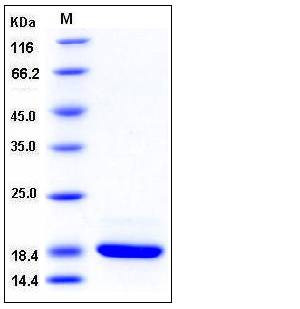Human REG3G / PAP1B Protein (His Tag)
LPPM429,PAP-1B,PAP1B,PAPIB,REG-III,REGIII,UNQ429
- 100ug (NPP4213) Please inquiry
| Catalog Number | P11641-H08H |
|---|---|
| Organism Species | Human |
| Host | Human Cells |
| Synonyms | LPPM429,PAP-1B,PAP1B,PAPIB,REG-III,REGIII,UNQ429 |
| Molecular Weight | The recombinant human REG3G consists of 160 amino acids and migrates as an approximately 18 kDa band in SDS-PAGE under reducing conditions as predicted. |
| predicted N | Glu 27 |
| SDS-PAGE |  |
| Purity | > 97 % as determined by SDS-PAGE |
| Protein Construction | A DNA sequence encoding the human REG3G (NP_001008388.1) (Met 1-Asp 175) was fused with a polyhistidine tag at the C-terminus. |
| Bio-activity | |
| Research Area | Cancer |Signal transduction |Cytoskeleton / ECM |Cell Adhesion |Lectin |C-tyep lectin | |
| Formulation | Lyophilized from sterile PBS, pH 7.4 1. Normally 5 % - 8 % trehalose, mannitol and 0.01% Tween80 are added as protectants before lyophilization. Specific concentrations are included in the hardcopy of COA. |
| Background | Regenerating gene (Reg), first isolated from a regenerating islet cDNA library, encodes a secretory protein with a growth stimulating effect on pancreatic beta cells. Reg and Reg-related genes which were expressed in various organs have been revealed to constitute a multigene family, the Reg family, which consists of four subtypes (types I, II, III, IV) based on the primary structures of the encoded proteins of the genes, which are associated with tissue repair and have been directly implicated in pancreatic beta-cell regeneration. Reg proteins are expressed in various organs and are involved in cancers and neurodegenerative diseases. They display a typical C-type lectin-like domain but possess additional highly conserved amino acids. Regenerating islet-derived 3 gamma (REG3G), also known as pancreatitis-associated protein 1B (PAP1B), is a member of the secreted Reg superfamily and contains one typical C-type lectin domain. REG3G is expressed weakly in pancreas, strongly in intestinal tract, but not in hyperplastic islets REG3G might be a stress protein involved in the control of bacterial proliferation. It was indicated that REG3G specifically targets Gram-positive bacteria because it binds to their surface peptidoglycan layer, and serves as one of several antimicrobial peptides produced by paneth cells via stimulation of toll-like receptors (TLRs) by pathogen-associated molecular patterns (PAMPs). |
| Reference |
